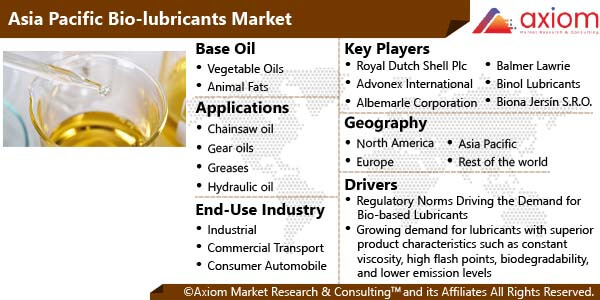Bio lubricants is interpreted as a lubricant obtained from natural raw materials both vegetable and animal oils, renewable and which are non-toxic to humans. Vegetable oil used for the production of bio-lubricant may be obtained from plant seeds, such as vegetable oils which may be consumed or which cannot be consumed. Moreover increasing amount of environmental pollution can be solved by replacing petroleum lubricant with bio lubricant those have made from vegetable oils will propel the demand in the market. The use of bio lubricants is particularly relevant to certain environments in which environmental protection is a constant concern. This is particularly true of aquatic, mountain, agricultural and forest environments. Vegetable oil can affect the characteristics to be generated bio-lubricant due to its composition of fatty acids. Vegetable oils with more double chains will have a higher pouring point and a lower stability of oxidation. Bio lubricants are used in various applications such as agriculture, forestry, transportation, mining, automotive, fishing, chain saw oils, transmission oils, engine oils and hydraulic oils and are used to minimize friction between surfaces in mutual contact.
Asia Pacific Bio-lubricants Market Report Outlook
The key factor for the growth of Asia Pacific bio-lubricants market is growing demand for lubricants with superior product characteristics such as constant viscosity, high flash points, biodegradability, and lower emission levels. More importantly, these bio-lubricants are biodegradable, generally less toxic and renewable, reduce dependency on imported petroleum oils. Besides, regulatory norms driving the demand for bio-based lubricants is fueling the growth. The major bio-lubricants manufacturers are working more closely with the lubricant industry to design additives that are suitable for improving the performance and are more environmentally benign.
COVID 19 IMPACT ON ASIA PACIFIC BIO-LUBRICANTS MARKET REPORT
The exclusive COVID 19 impact analysis report by Axiom MRC provides a 3600 analysis of micro and macro-economic factors on the bio-lubricants market. In addition, complete analysis of changes on the bio-lubricants market expenditure, economic and international policies on supply and demand side. The report also studies the impact of pandemic on global economies, international trade, business investments, GDP and marketing strategies of key players present in the market. COVID-19 impact on the bio-lubricants market was negative due to pandemic the entire production was disrupted which also had an adverse effect on supply chain of bio-lubricants.
ASIA PACIFIC BIO-LUBRICANTS MARKET SEGMENTAL OVERVIEW
The bio-lubricants market is segmented based on by base oil, by application, by end-use industry and by geography.
ASIA PACIFIC BIO-LUBRICANTS MARKET BY BASE OIL
The bio-lubricants are available in different base oil types including vegetable oils, animal fats. Vegetable oil is further bifurcated to canola, palm oil, rapeseed and sunflower. Vegetable base oil is expected to dominate in the bio-lubricants market by base oil type owing to high biodegradability, cost-effectiveness, renewability, and lower environmental effects, less toxic, and high lubricity. The growth can also be attributed to the abundant availability of vegetable oil seeds used as raw materials.
ASIA PACIFIC BIO-LUBRICANTS MARKET BY APPLICATION
Bio-lubricants market has major application in chainsaw oil, gear oils, greases, hydraulic oil, metalworking fluids, mold release agents, two-cycle engine oils. Bio-lubricants hydraulic oils has an increasing trend of replacing conventional petroleum and synthetic hydraulic fluids. In addition, bio-hydraulic fluids offer the same or better performance than conventional petroleum or synthetic hydraulic fluids, while offering a decisive environmental advantage. The expanding role of bio-lubricants hydraulic fluids is expected to witness highest growth during the forecast period.
ASIA PACIFIC BIO-LUBRICANTS MARKET BY END-USE INDUSTRY
The Bio-lubricants market had its end use in industrial, commercial transport, consumer automobile. Industrial is further sub- segmented to energy & power, foods & pharmaceuticals, marine, mining & metallurgy. Industrial is projected to have the largest end user of bio-lubricants owing to demand from marine industry and agriculture & construction industry. Besides, Commercial transport is anticipated to grow at the highest pace owing to growing maintenance in heavy and light-duty trucks. Also, consumers are investing in advanced innovative products which will enhance performance with fuel efficiency regulations. In addition, private sector investments and various automotive companies working towards the development of ultra-low emission vehicles in order to comply with transitional regulatory requirements are also expected to fuel demand for biolubricants over the forecast period.
ASIA PACIFIC BIO-LUBRICANTS MARKET BY GEOGRAPHY
The Asia Pacific bio-lubricants market is studied for the following countries Japan, China, India, and rest of APAC including Australia, Singapore, Thailand, Indonesia, Malaysia and Philippines. Asia Pacific is anticipated to be the fastest growing region in terms of consumers as the region is largest automobile manufacturing hubs. In addition, countries like China, India, Indonesia, and Thailand are increasingly manufacturing and exporting passenger cars and other vehicles to developed regions s fueling the growth of bio-lubricants market.
ASIA PACIFIC BIO-LUBRICANTS MARKET KEY PLAYER
The key players in Asia Pacific bio-lubricants market are Royal Dutch Shell Plc, Magna Group, Green Earth Technologies, Polnox Corporation, Kluber Lubrication Munchen Se & Co. Kg, Castrol Limited, Exxon Mobil Corporation., Mmxix Dsi Ventures, Inc., Chevron Corporation, Rsc Bio Solution, Biosynthetic Technologies, Bechem, Citgo Petroleum Corporation and Rocol among others.
ASIA PACIFIC BIO-LUBRICANTS MARKET RECENT DEVELOPMENT
December 2019: ExxonMobil looks to set up lubes blending plant in India. The company wants the facility to be one of its largest in Asia with over 500,000 barrels per year capacity.











